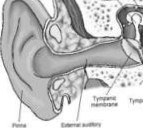Wax per se is not a disease at all. It is just the secretion of the ceruminous glands in the skin lining the ear canal. These glands are similar to the sweat and oil-secreting glands of the skin elsewhere on the body. Ear wax is a yellowish-brown waxy substance meant to moisturise and protect the delicate skin lining the ear canal. Excess wax is drained imperceptively by nature’s mechanisms along with the shed exfoliated skin.
The texture of wax may vary from soft and wet, to very hard and dry and is genetically determined. The ear canal comes in diverse sizes and shapes, wide and straight at one end of the spectrum and narrow and tortuous at the other end. There can be various permutations and combinations of these. These factors determine the ease of drainage of the wax.

In a good majority of people, these are not a matter of concern, and they go through life without ever having to visit a doctor at all for this problem. Only in a very few unfortunate ones, the texture of the wax is hard and dry, and the shape of the canal is narrow and tortuous. People with this combination can expect frequent and recurrent problems like blockage or pain in the ears, especially if they have the habit of fiddling with their ears. Scratching the ears stimulates the ceruminous glands to produce more wax than is needed and the injury due to the scratching encourages infections which in turn causes more itching. A vicious cycle soon sets in. Improper attempts at removal may cause the wax to get pushed deeper into the ear canal ramming the wax against the ear canal. Frequent and long term use of the plugin earphones in today’s world can also be a cause for impacted wax.

Impacted wax can cause severe excruciating earache and may necessitate its removal under general anaesthesia. In such cases, it is better to get the wax cleaned frequently, maybe once every three months or so. Wax solvent ear drops or baby oil for a few days before the hospital visit will make the experience less unpleasant. Most of the times, if one does not interfere with nature’s mechanisms, the wax self-drains and rarely, if ever, needs a visit to the doctor. The doctor may remove the wax under direct vision or with the aid of a microscope, using swab sticks, suctioning or by syringing. Syringing uses warm water under pressure to tease out the wax. This method is not very comfortable for the patient in addition to putting the eardrum at the risk of perforation. Drying the ear canal after the procedure is a must to prevent fungal infections. The high complication rates have brought disrepute to syringing. The eardrum is a delicate membranous structure which is safely housed deep in the ear canal. It protects the deeper structures of the ear. It may be ruptured either by direct injury or indirectly by pressure changes within the ear. Small perforations may heal spontaneously, while larger ones need grafting under a microscope. Infections in the middle ear may by its proximity, spread intracranially and cause meningitis and brain abscesses.

On the wayside, one often chances upon fraudsters fooling onlookers by pouring in hydrogen peroxide into the ear canal resulting in impressive bubbles. I have heard that some of these tricksters by a sleight of hand bring out a chunk of thick tamarind paste to mimic ear wax. Trust me, the wax especially if impacted is not amenable to such trickery. Some even try syringing with warm water which could accomplish the task. However, the procedure is not without risk to the eardrum if performed by an untrained hand. I have come across a rather foolhardy solution for the problem on the internet called ‘Candling the wax’.It involves trying to bring out the wax with a combination of heat and suction with a hollow candle inserted in the ear and lit at the other end! I am sure none will try it.
At the end of this spectrum of waxy disorders, is a condition called the Keratosis Obturans. Impacted wax traps the exfoliated skin of the ear canal deep to it. Shedding of the superficial layers of the skin is a natural and continuous phenomenon all over the body. The trapped debris exerts increasing pressure on the bone as its volume increases with time, resulting in excruciating pain. This whitish keratinous debris under pressure tends to erode the bone of the ear canal, which now loses its smooth outline. These irregularities hamper nature’s mechanism of cleaning. The debris will now need to be frequently removed by a doctor, at least once in the three months, to prevent complications.
The bone erosion, if allowed to progress, may extend to involve the neighbouring structures of the ear. The brain, major blood vessels and the facial nerve in addition to the middle ear, are all at risk. Of particular note is the paralysis of the facial nerve which supplies the muscles of facial expression, and its damage results in a distorted face. I can recall many such cases wherein I have followed the patient through the various stages starting with itching and wax and later impacted wax and then Keratosis and finally its complications. As already explained in a previous post- ‘An itch for an itch’, scratching or probing the ear canal by any tool, is no solution. Dangerous and life-threatening complications may ensue. Once complications set in, of course, all are ready to change though a tad late. Better late than never holds good here too.


Waxing n waning problems of ear wax very well described.Your article took me back to our MBBS days when syringing of ears was an OPD procedure. If the direction of the syringe nozzle misfired, the patient would fainted. Also the ear wax with fungal infection looked like a wet newspaper ball. Do I remember correctly ?
Yes! Your memory serves you well. Syringing could even result in a perforation of the tympanic membrane in addition to vasovagal syncope if the aim went wrong.
Reena dear you write so vividly,a lay man will understand easily.Keep up the good work of sharing your ENT knowledge
Thanks, dear for the encouragement